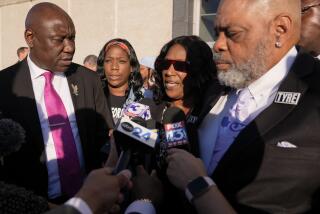The Law Struggles for Justice : In difficult case, judge sentences officers to jail
- Share via
No sentence U.S. District Judge John G. Davies handed down against the two Los Angeles policemen convicted in the King beating case could have satisfied everybody.
Too short a sentence would have angered those who saw Rodney G. King as a symbol of all victims of police brutality. Too long a sentence would have angered those who worry that attempts to control police behavior put officers at a potentially lethal disadvantage in dealing with criminals.
But that said, Davies’ decision to send Sgt. Stacey C. Koon and Officer Laurence M. Powell to prison for only 30 months was unexpected.
EXPECTATION: It was unexpected because federal sentencing guidelines would seem to have required longer terms, in the range of four to six years. Of course, few seriously thought that Davies would impose the maximum 10 years on Koon and nine on Powell, who were convicted of violating King’s civil rights when they beat the black motorist in March, 1991. Prosecutors had sought seven to nine years in prison for Powell, who delivered most of the blows, and nine to 10 years for Koon, who as the sergeant in command failed to control Powell.
What gave the King case its wide symbolic impact--apart from the fact it was graphically captured on a now infamous videotape--is the fact the blows continued well after King was under control, blows that came from officers of the law. So while the symbolic impact of any prison time for police officers is not to be underestimated, such short sentences may raise new questions and controversy.
WORRY: Can we be sure other law enforcement officers will get the message--that acting under color of law is no excuse for administering summary street justice? And how much more loaded with symbolic freight has the Reginald Denny beating case now become?
The trial in that incident, which occurred during the 1992 riots, has just begun. The problem is that some will dwell on the obvious parallels: a videotaped beating in which an outnumbered victim is pummeled.
Of course in important respects the two cases are unalike--one happened in the course of a lawful attempt by police officers to make an arrest, the other in the early stage of an urban riot. But some, emphasizing only that in the Denny case the victim is white and the suspects are black, will draw their own conclusions if the Denny suspects are found guilty and receive longer terms.
These have been difficult times for most of us. Maybe one response to the troubling questions that have arisen is to heed the advice of Mayor Richard Riordan, who Wednesday called on Angelenos to become more neighborly--to get to know and understand each other better.
The mayor himself could set an example to show Angelenos just how they should go about accomplishing something that is simple in concept but difficult to do in this dispersed and segregated city. For as Pollyannaish as “getting to know each other better” sounds, it just might be the best hope for this community after all.
More to Read
Sign up for Essential California
The most important California stories and recommendations in your inbox every morning.
You may occasionally receive promotional content from the Los Angeles Times.













